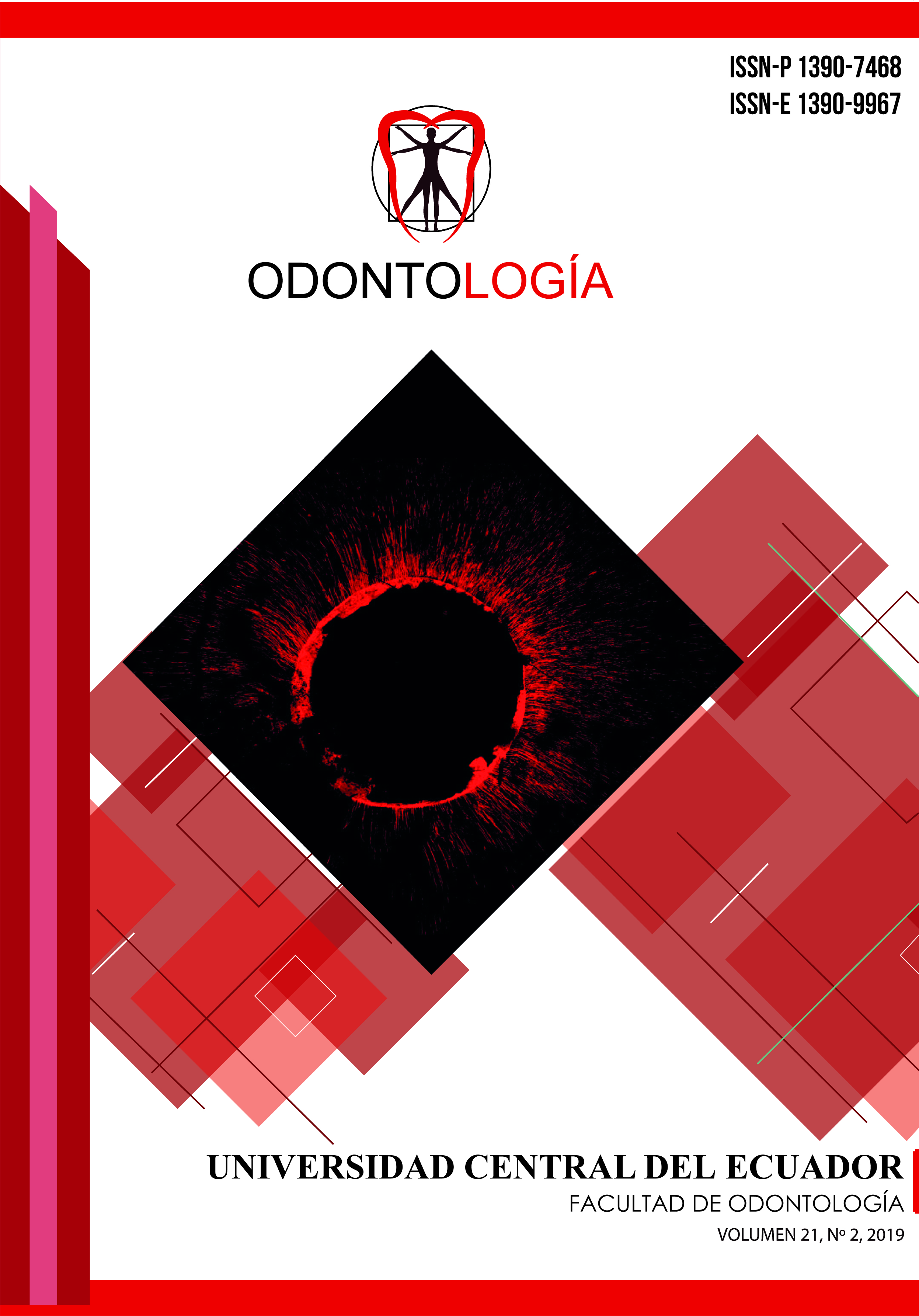Desgaste del esmalte por diferentes tratamientos químicos y mecánicos
DOI:
https://doi.org/10.29166/odontologia.vol21.n2.2019-51-66Palabras clave:
Dental Enamel, Dental Polishing/methods, Dental Enamel/drug effects, Enamel Microabrasion/methods, Air AbrasionResumen
Introducción: La microabrasión se describe como un procedimiento realizado sobre el esmalte dental en el cual mediante la utilización de un agente ácido y un agente abrasivo se logra corregir alteraciones cromáticas superficiales. Algunos estudios demuestran como los parámetros de tiempo, número de aplicaciones y la presión ejercida, influyen en la cantidad de esmalte eliminado. Objetivo: Establecer el espesor de esmalte dental eliminado según la capacidad abrasiva de 9 tratamientos químico mecánicos, mediante estereomicroscopia. Materiales y métodos: Con el aval del comité de ética de la Facultad de Odontología de la Universidad Nacional de Colombia, se recolectaron 90 terceros molares bajo consentimiento informado y se mantuvieron almacenados bajo los parámetros de la norma ISO 11405. Sobre bloques de acrílico se fijaron las mitades linguales de las coronas dentales, creando sobre ellas superficies planas mediante serie de lijas con irrigación y tomando impresiones con silicona de adición. Se distribuyeron de forma aleatoria en 9 grupos (n 10). Cada grupo recibió un tratamiento por un periodo de 30 segundos: G1: Opalustre® (Ultradent), G2: Piedra pómez y ácido fosfórico al 37% (Ultra-Etch®, Ultradent), G3: Piedra pómez, glicerina y ácido fosfórico al 37% (Ultra-Etch®, Ultradent), G4: Fresas de halo amarillo (Komet), G5: Fresas de halo blanco (Komet), G6: Discos Sof-Lex® (3M), color amarillo, G7: Discos Sof-Lex® (3M), color amarillo y amarillo claro, G8: Arenado, y G9: Puntas ultrasónicas Perfect Margin (Acteon). El espesor de desgaste creado fue medido utilizando un estéreo microscopio con un aumento de 10X. Los datos recolectados se analizaron a través de las pruebas de Kruskal-Wallis (p≤0.05) para comparar todos los grupos y la prueba U de Mann-Whitney (p≤0.05) para comparaciones individuales. Resultados: Independientemente del tratamiento realizado todos los grupos presentaron un desgaste del esmalte. El mayor desgaste se registró para el grupo tratado con fresa de halo amarillo (122,66 ± 22,64µm) y el menor desgaste para el grupo de arenado (11,5 ± 2,36µm). Se presentó diferencia estadísticamente significativa entre todos los grupos. Conclusiones: Bajo las limitaciones del presente estudio se puede concluir: La mayor microabrasión en esmalte se produjo con fresas de grano extrafino (halo amarillo) y el menor desgaste se produjo con arenado.
Descargas
Citas
McCloskey, RJ. A technique for removal of fluorosis stains. The Journal of the American Dental Association. 1984. 109(1), 63–64.
Álvarez M, Quiroz K, Rodriguez V, Castelo RM. Dental microabrasion in children: An esthetic alternative. Odontol. Sanmarquina. 2009; 12(2): 86-89
Croll TP, Cavanaugh R. Enamel color modification by controlled hydrochloric acid and pumice abrasion. Quintessence Int. 1986; 7 (2): 26-28.
Mondelli J, Mondelli RFL, Bastos MT, Franco EB. Microabrasão com ácido fosfórico. Rev. bras. de Odont.1995. 52(3): 20-22.
Meireles SS, Andre Dde A, Leida FL, Bocangel JS, Demarco FF. Surface roughness and enamel loss with two microabrasion techniques. J Contemp Dent Pract. 2009;10:58–65.
Bertacci A, Lucchese A, Taddei P, Gherlone EF, Chersoni S. Enamel structural changes induced by hydrochoric and phosphoric acid treatment. J Appl Biomater Funct Mater. 2014;12(3):240 -247.
Ardu S, Benbachir, Sttavridakis M, Dietshi D, Krejci, Feilzer. A combined chemo-mechanical approach for aestetic managemof superficial enamel defects. A British Dental Journal. 2009;206(4): 205-208.
Tong LSM, Pang MKM, Mok NYC, King NM, Wei SHY. The effects of etching, micro-abrasion, and bleaching of surface enamel. Journal of Dental Restauration.1993;72(1):67-71.
Agudelo LJ. Efecto de dos sistemas de microabrasión en el espesor del esmalte dental. [Tesis]. Bogotá: Universidad Nacional de Colombia. 2017.
van Waveren Hogervorst WL, Feilzer AJ, Prahl-Andersen B. The air-abrasion technique versus the conventional acid-etching technique: A quantification of surface enamel loss and a comparison of shear bond strength. American Journal of Orthodontics and Dentofacial Orthopedics. 2000;117(1):20-6.
Pini NIP, Costa R, Bertoldo CE, Aguiar FH, Lovadino JR, D Alves. Enamel morphology after microabrasion with experimental compounds. Contemp Clin Dent. 2015;6(2):170–175.
Lambrechts P, Mattar D, De Muck J, Bergmans L, Peumans M, Vanherle G, Van Merrbeeck B. Air-abrasion enamel microsurgery to treat enamel White spot lesions of traumatic origin. Masters of esthetic dentistry. 2002. 14 (3) 167-187.
Sundfeld RH, Briso ALF, Mauro SJ. Smile recovery. IV. External whitening of traumatized teeth. J Bras Clin Estet Odontol 2000;5:29-35.
Rodrigues MC, Mondelli RFL, Oliveira GU, Franco EB, Baseggio W, Wang L. Minimal alterations on the enamel surface by micro-abrasion: in vitro roughness and wear assessments. J. Appl. Oral Sci. [Internet]. 2013. [cited 2018 Oct 20] ; 21 (2): 112-117.
Paic M, Sener B, Schug J, Schmidlin PR. Effects of microabrasion on substance loss, surface roughness, and colorimetric changes on enamel in vitro. Quintessence International. 39 (6): 517-522.
Bertoldo C, Lima D, Fragoso L, Ambrosano G, Aguiar F, Lovadino J. Evaluation of the effect of different methods of microabrasion and polishing on surface roughness of dental enamel. Indian J Dent Res. 2014 May-Jun;25(3):290-3
Publicado
Cómo citar
Número
Sección
Licencia
Derechos de autor 2020 Juan Norberto Calvo Ramírez, Lina María Arango

Esta obra está bajo una licencia internacional Creative Commons Atribución-NoComercial-SinDerivadas 4.0.


